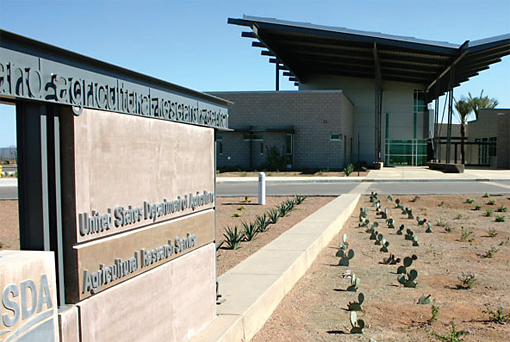| 제목 | [DAIKIN] GOVERNMENT - Arizona Arid-Land Research Center | 작성일 | 16-06-16 14:35 |
| 글쓴이 | 최고관리자 | 조회수 | 3,717 |
본문
CASE STUDY
Government
Name
U.S. Arid-Land Agricultural Research Center
Location
Maricopa, AZ USA
Facility Size
Nine buildings totaling 98,000 ft2 with greenhouses, laboratories and office space stories
Issue
Efficient cooling, precise temperature control and high indoor air quality (IAQ)
Solution
Daikin Genesys® air-cooled compressor chillers, Vision® indoor air handlers, Skyline® outdoor air handlers
Daikin air handlers and air-cooled chillers handle the Arizona heat at
new research facility
Daikin helps research facility earn Federal Energy Saver Showcase award
Cooling a building in the Arizona desert-and doing it efficiently-seems about as possible as getting water from a stone. At the U.S. Arid-Land Agricultural Research Center in Maricopa, AZ, engineers designed a cooling system for not one but nine buildings totaling 98,000 square feet and varying from greenhouses to laboratories to office space. They met the efficiency goal so well that the facility received a 2003 Federal Energy Saver Showcase award from the U.S. Department of Energy.
Scientists at the new agricultural facility study ways to improve cotton production and conserve water in arid and semiarid land. In addition to efficient cooling, HVAC requirements included precise temperature control and high indoor air quality (IAQ) to service laboratory space.
"We had specific requirements to meet, based on government guidelines," said Russ Mulholland, design engineer with The SmithGroup of Phoenix. "They included part-load operating efficiencies, energy recovery units, quiet operation and high IAQ." Mulholland and his team worked with Climatec of Phoenix, the Daikin representative, to provide all the equipment necessary: Vision indoor air handlers, Skyline outdoor air handlers, and GeneSys air-cooled screw compressor chillers.
A premier agricultural research center The $28 million Research Center is operated by the Agricultural Research Service (ARS), the chief research agency of the U.S. Department of Agriculture. Located on a 20-acre campus it shares with the University of Arizona's Maricopa Agricultural Center, the facility houses 30 scientists and support staff and combines two ARS laboratories previously located in Phoenix. The U.S. Water Conservation Research Laboratory conducts research on how crops will perform in the future as atmospheric carbon dioxide levels increase. The Western Cotton Research laboratory develops ways to help farmers grow cotton more efficiently and minimize damage from diseases and pests.
"This new center will be one of the premier agricultural research centers in the world dealing with issues of arid and semiarid lands," said Antoinette Betschart, director for the ARS Pacific West Area, during ground-breaking ceremonies in February 2004.
Helping to meet the facility's mission
The cornerstone of the facility's central cooling system, and a major reason for its efficiency, is Daikin's GeneSys air-cooled screw compressor chiller. Designed around a unique single screw compressor technology (a single main rotor and two gate rotors) and equipped with variable frequency drives, the chiller delivers up to 14.0 EER at part load IPLV. The screw compressor design is virtually vibration-free to minimize transmitted sound. The chiller's solid state starters monitor power quality and minimize component stress during start-up and shut-down, which in turn can help extend the chiller's operating expectancy and improve reliability. And because the air-cooled chiller produces chilled water without requiring a separate cooling tower, engineers were able to reduce installed costs and maintenance while keeping the system relatively simple as well as environmentally friendly. "In addition to operating requirements, we needed a chiller that uses HFC refrigerant, and this uses HFC-134a," said Mulholland. HFC- 134a has zero ozone depletion potential, and no phase-out date.

Daikin Genesys air-cooled screw compressor chillers deliver up to 14 EER at part load and use HFC-134a refrigerant with no ozone depletion or phase-out date.
Yet with outside temperatures hovering at 115 degrees F, even an efficient chiller needs energy-saving support. Four Daikin Vision indoor air handlers with energy recovery coils help to recover as much as 75 percent of the sensible (heat) energy from the exhaust air stream and transfer it to the supply air stream. Standard re-circulating air conditioners (such as fan coils) deliver the conditioned air to individual spaces via ducted, forced air. "We pull in 100 percent fresh air at 115-degree ambient," said Mulholland. "The energy recovery coils are a great help because we can recover some of that conditioned air before exhausting it."
Vision air handling units are built on a rules-built, variable dimension software platform, meaning engineers can quickly and easily select configurations and components to properly function and fit their project, at a much lower cost than a custom installation. IAQ and energy efficiency is achieved through standard features such as insulated double-wall construction with a smooth inner liner and gasketed frame channel, double-sloped drain pan, high efficient filters and optimal performing fans.
The entire system is controlled by an Alerton® building automation system (BAS). MicroTech® II unit controllers on the chiller provided local monitoring and control via BACnet communications, and facilitated easy integration into the BAS with the Procotol Selectability® feature.
Because of the strict requirements for laboratories and greenhouses, some areas are evaporative-cooled, and others have individual systems tied into the central chilled water system. An additional six Daikin Skyline outdoor air handlers help circulate air to the greenhouses.
An energy-saving oasis in the desert Even before its completion, the U.S. Arid-Land Agriculture Research Center received the Federal Energy Saver Showcase award in 2003, one of 20 Federal facilities to receive the recognition that year. The award program is operated by the Federal Energy Management Program, a unit of the U.S. Department of Energy. The purpose of the award is to promote wise energy and water use throughout the Federal government and to increase awareness of energy-efficient and renewable energy technologies applicable to all Federal facilities.
The research center in Maricopa incorporates a variety of energy saving features, including daylighting, glazing and thermal break frames, occupancy sensors, and automatic daylight controls. Its efficient HVAC system includes direct digital controllers, variable frequency drives and energy recovery devices. Combined with water-efficient plumbing, rainwater collection and a wetland sewage treatment system, the Agricultural Resource Center is an energy oasis in the desert.

Four Daikin Vision indoor air handlers with energy recovery coils help to recover energy from the exhaust air stream and use it to pre-treat the supply air stream, helping to save on ventilation and energy costs.
| 이전글 | [DAIKIN] GOVERNMENT - AJ Celebrezze Federal Building 2016-06-16 | ||
| 다음글 | [DAIKIN] GOVERNMENT - Auburn Memorial City Hall 2016-06-16 | ||






